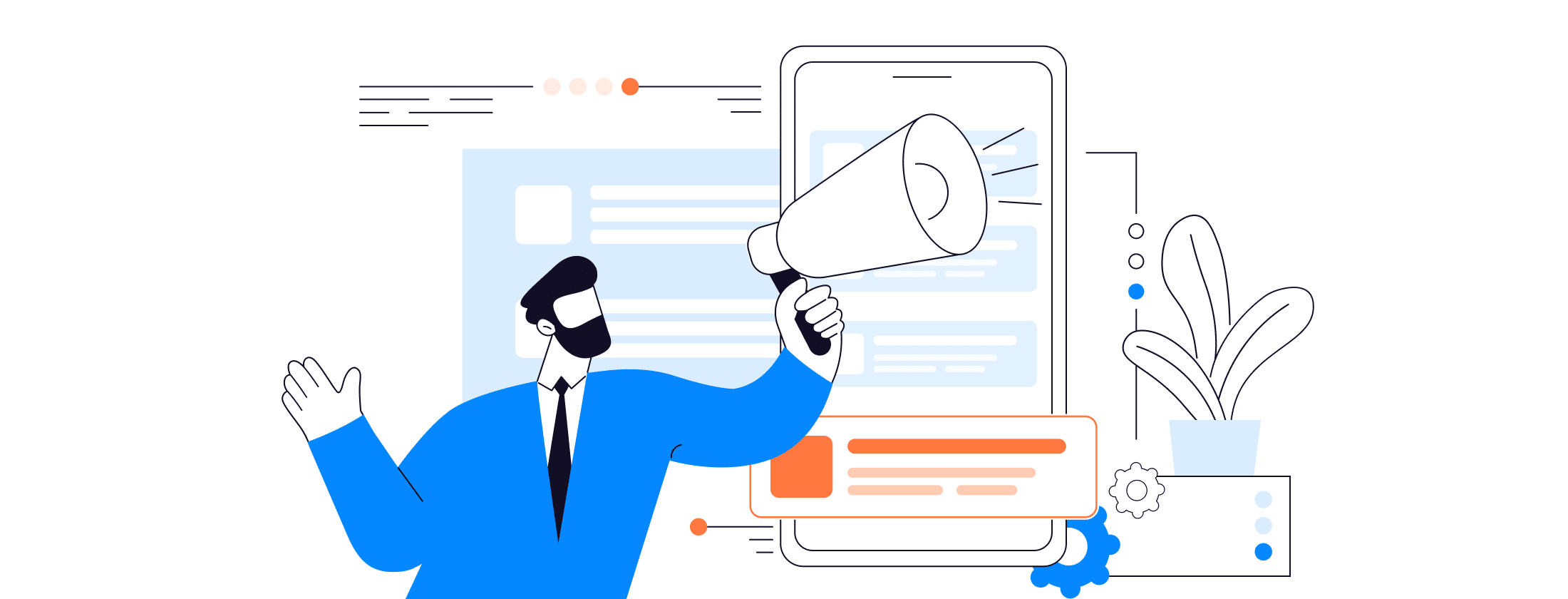
Nowadays, catching clients’ attention is harder than ever due to digitalization. Push ads solve this task much more effectively in comparison with other ad formats. The secret of push ads’ success is that this ad type is user-friendly and notable. Surely everyone came across push advertising more than once.
Read on to learn more about push notifications: their peculiarities, pros and cons, and how to reach maximum conversion rates through this ad type. Here is a complete push ads review that will be helpful for affiliate marketers, publishers, and anyone who wants to become a push ads guru.
Before diving into the high-level push notification solutions, let’s start with the fundamentals and definitions.
Push notifications are clickable pop-up messages displayed on device screens, chiefly desktops and smartphones. The technology originally served for sending non-advertising notifications. Apple was the first who implemented push technology for its devices in 2009. The company created Apple Push Notification service (APNs) that enabled iOS developers to send notifications to apps installed on Apple devices.
Today push notifications are well-known as advertising technology that is supported by Android, giants Google and Microsoft. Push notification ads also can be viewed almost on most browsers and delivered on any smart devices that are connected to the Internet, for example, tablets and consoles. Despite the fact that push ads appear literally anywhere, they are voluntary. The point is, users should subscribe to notifications before they start receiving push ads.
Push ads are based on the subscription model. Let’s see how it works.
A user visits the website and sees the window with the proposal to subscribe for getting notifications.
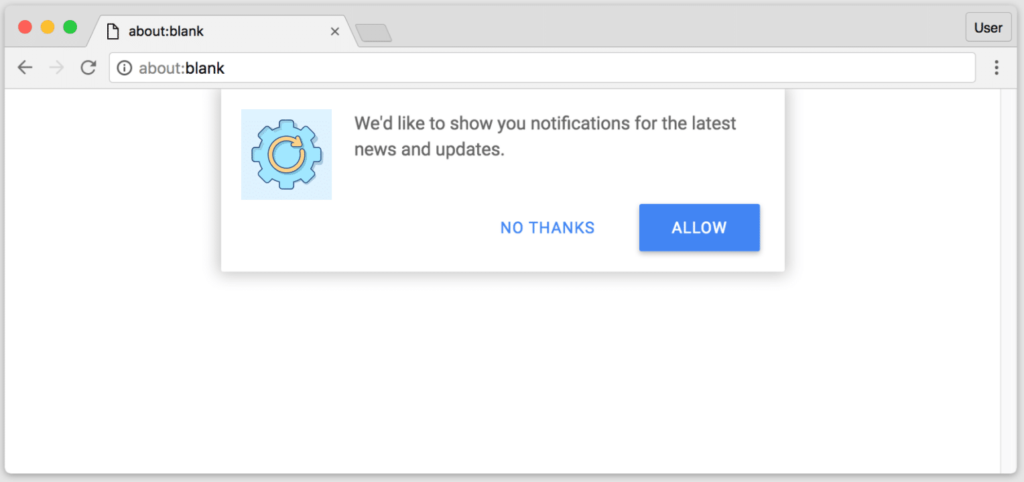
Website visitors can click the subscribe button or close the window. Users who choose the first option become push ad recipients soon. They start getting notifications that look something like the following:

Looking at the samples of notifications above, we’ll describe their elements:
See the best push notification examples to create effective marketing push ad campaigns.
All elements are clickable since a push ad contains a URL that allows users to land on the offer page or pre-landing containing a link to the landing page. The pre-landing page serves as part of the sales funnel which is an important stage of the user’s journey and a sort of filter for uninterested ad recipients.
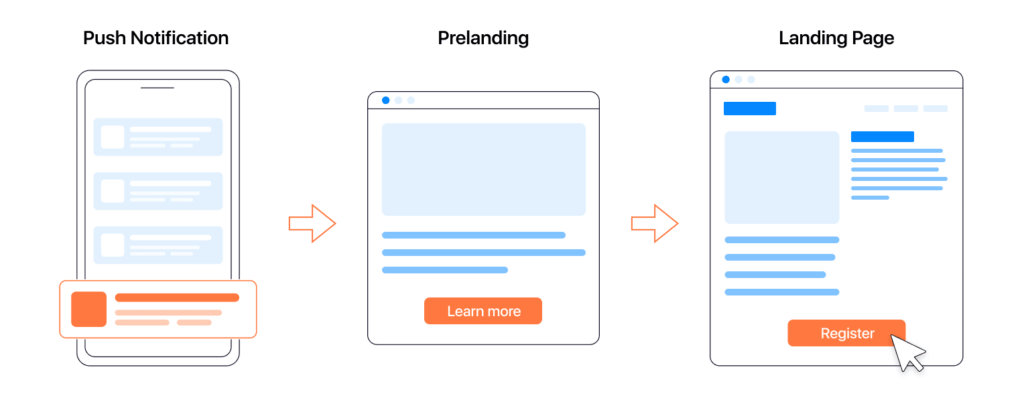
As you’ve seen, the main image is invisible to mobile screens. As a result, ads shown on mobile phones, resemble message notifications that users are accustomed to. Because of this similarity, push advertising is considered to be a type of native format. Unlike other native formats such as SMS and email advertising, push ads can be sent without the user providing contact details. The subscription is totally anonymous for all users.
At present, there are many types of push notifications available for advertising purposes. The most popular formats are the following:
Web push notifications
This technology implies sending out classic push notifications through desktop or mobile browsers. Usually, push ads pop up at the right-hand side or top of the screen, depending on the operating system being used by a subscriber.
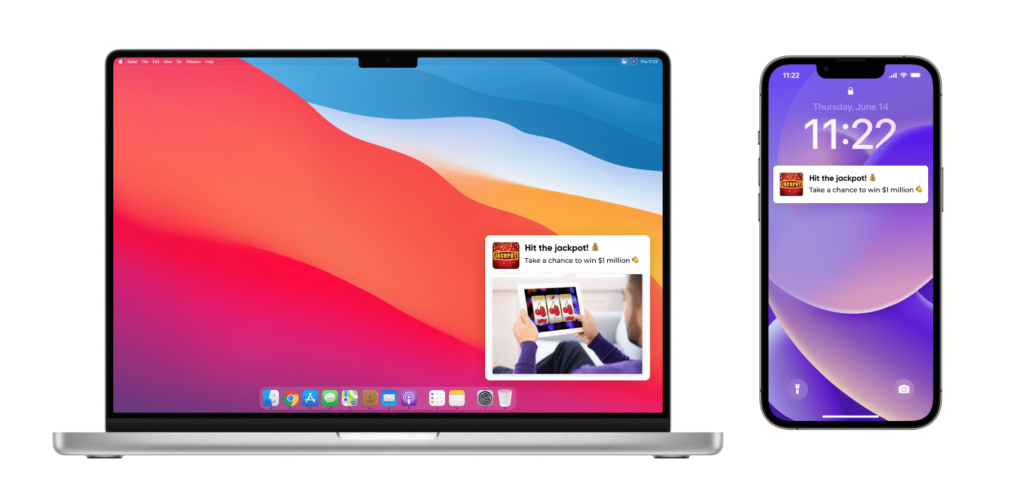
In-page push notifications
Unlike classic push notifications, in-page push ads are sort of popunders, stylized as push notifications. Notably, this ad type was invented in order to engage iOS users that hadn’t seen notifications from websites before.

Calendar iOS notifications
These ads are displayed on iOS devices via the сalendar application, imitating a scheduled event. Similar to push ads, users receive calendar notifications right on their devices regardless of whether they are online or not.

It’s worth trying various push formats beyond classic web push notifications, and there is one simple reason for this: whatever the advertising, users get tired of the traditional push ads.
Marketers who decide to try push ads often discover that this format makes more profit than the others. And they have powerful reasons for it.
Benefits of push ads:
Just as every medal has its reverse, push format has its downsides.
Downsides of push ads:
Push advertising is useful as a way to cover a wide variety of verticals. The following verticals tend to have higher click-through and conversion rates than the other ones, which makes them more profitable for marketers.
The list of best verticals for push notifications:
As some verticals, like Adult, Dating (Adult and Mainstream), Gambling, and Sweepstakes are prohibited in social networks, running push ads become almost the only appropriate solution for the promotion of such offers. Note that some restrictions may also be related to the laws of a particular country. For example, Gambling or Betting offers are forbidden for advertising in the United Arab Emirates.
Due to the adaptability of push notifications, it is impossible to say which vertical performs best, but it’s definitely worth focusing on not too-specific offers because of the lack of interest-based targeting.
We’ll explain some technical aspects of push campaigns related to their setup, and then tell you how to get the most out of this knowledge.
The targeting methods for push campaigns and social media campaigns are quite distinct. Social media platforms provide a wider range of targeting options that utilize users’ personal information, such as their age, gender, and interests. Additionally, users actively input this information when creating their accounts.
While social media collect personal data, almost nothing is known about the browser users. Everything you can learn about the target audience comes down to device options, browser parameters and geolocations.
Here are 4 conditional targeting categories in push ad campaigns:
Even though push notifications are voluntary, not all users are equally interested in the notifications they subscribe to. Traffic segmentation helps to discover what audience group is the most effective.
Push traffic can be divided into 2 groups, depending on the following factors:
By targeting premium sources, advertisers can maximize campaign results, while sources with standard or low performance can be used for further scaling.
Most of the used cost models in push advertising are CPC and CPM.
Let’s take a closer look at them:
| CPC | CPM |
|---|---|
| Stands for: Cost Per Click | Stand for: Cost Per Mille (1K impressions) |
| Context: Advertisers pay for only user’s clicks | Context: Advertisers pay for every 1K impressions |
| Best for: Generation of conversion-centered campaigns | Best for: Broad audience marketing, in particular increasing brand awareness |
Read the article to sort out what the model is best for you:
Advertisers often choose the CPC cost model because of knowing how many clicks they can get according to their campaign budget. And on this basis, the CPC model seems to be more simple and less risky, unlike CPM.
To promote their offers, advertisers need publishers who have their own websites. Publishers or site owners, in turn, are interested in collaboration with advertisers because their purpose is to monetize existing traffic. Obviously, publishers can create an opt-in form for collecting subscriptions through a special plugin, but this way takes much time and reach only website visitors.
The most effective way to monetize or buy traffic is cooperation with push ad agencies that meet the needs of both sides:
Push ads networks aggregate many site owners in one place, giving access to a great amount of traffic for advertisers.
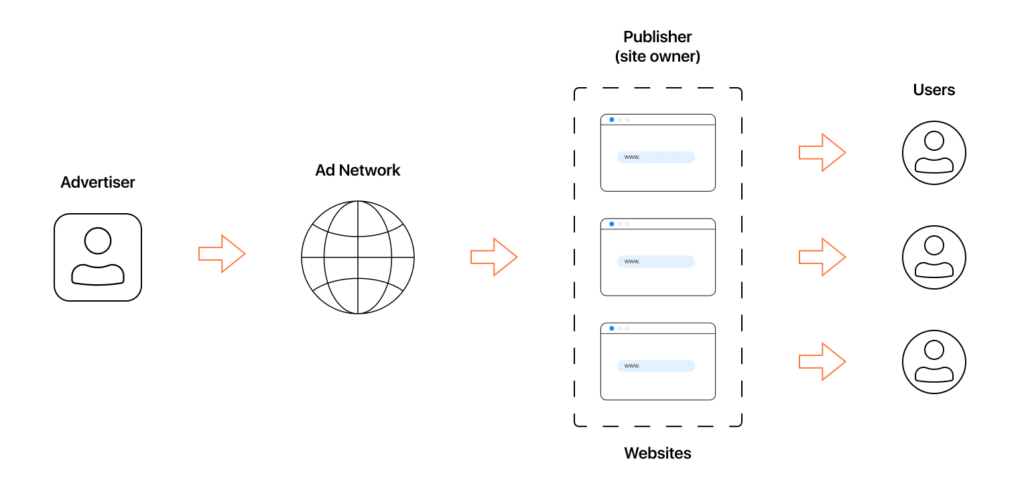
Subscribers lists are the largest traffic source in any ad platform. Each list can include several publishers. And accordingly, each publisher can have either one site or multiple ones.
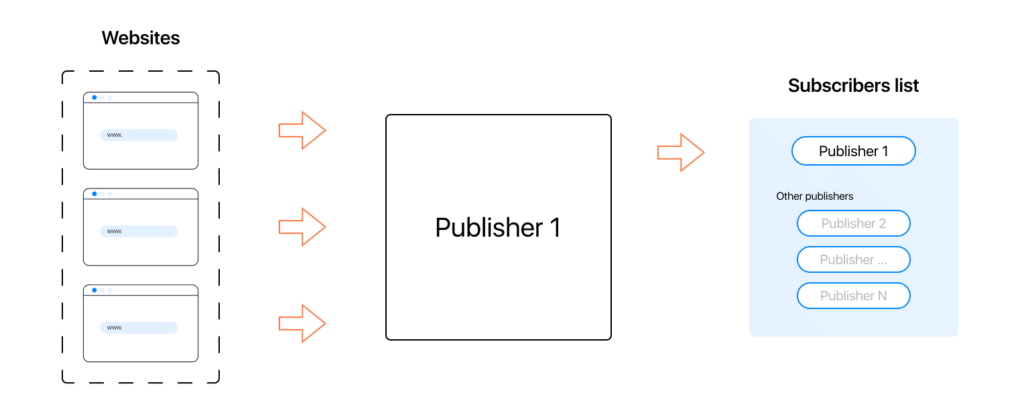
Networks offer full service for creating campaigns, not limited to only the collection of subscriber databases. These are multiple targeting options, subscribers lists prepared for particular verticals, optimization tools and other perks.
Benefits provided by networks:
Often publishers go to networks because they are looking for a more universal solution than just the plugin for collecting subscriptions. As far as marketers, they benefit from a great amount of traffic and multiple tools for optimization in ad networks for publishers.
The diversity of ad networks puzzles many advertisers. This choice is made easier if you know what you need to pay attention to.
The steps we outline below is a basis for any network.
Setting up push campaigns doesn’t imply as many targeting options as social media advertising accounts have. However, push technology provides large volumes of traffic compared to social networks. If a campaign is launched in some ad platform, there are also more opportunities for affiliates to optimize it. Thus, the success of a campaign depends on its proper setup.
Here, we’ll share the secrets of high-performance-based campaigns.
When choosing GEO, advertisers should consider that each country has its level of economic development, needs, culture and laws – all these factors influence on advertiser’s profit.
As GEOs are categorized in a tier system, you can focus on a particular group:
If you choose GEO from the Tier-1 group, you have a chance to get the largest payouts for offers, but the cost of this traffic will be high. Also, you can profit from the high traffic volumes of Tier-3 countries at a low price. The selection of GEO from the Tier-2 group is an alternative to mentioned options.
Choosing GEO impacts the potential amount of traffic that you can get. Affiliates can cover all countries while creating campaigns, provided that they have enough budget and time for testing and this strategy is appropriate.
Users’ attention is one of the most valuable commodities nowadays so push creatives are designed to attract it. Look at a few tips on how to make eye-catching creatives:

Icon should be simple and coupled with the main image. So, complex graphics or over-detailed icon isn’t the best option.
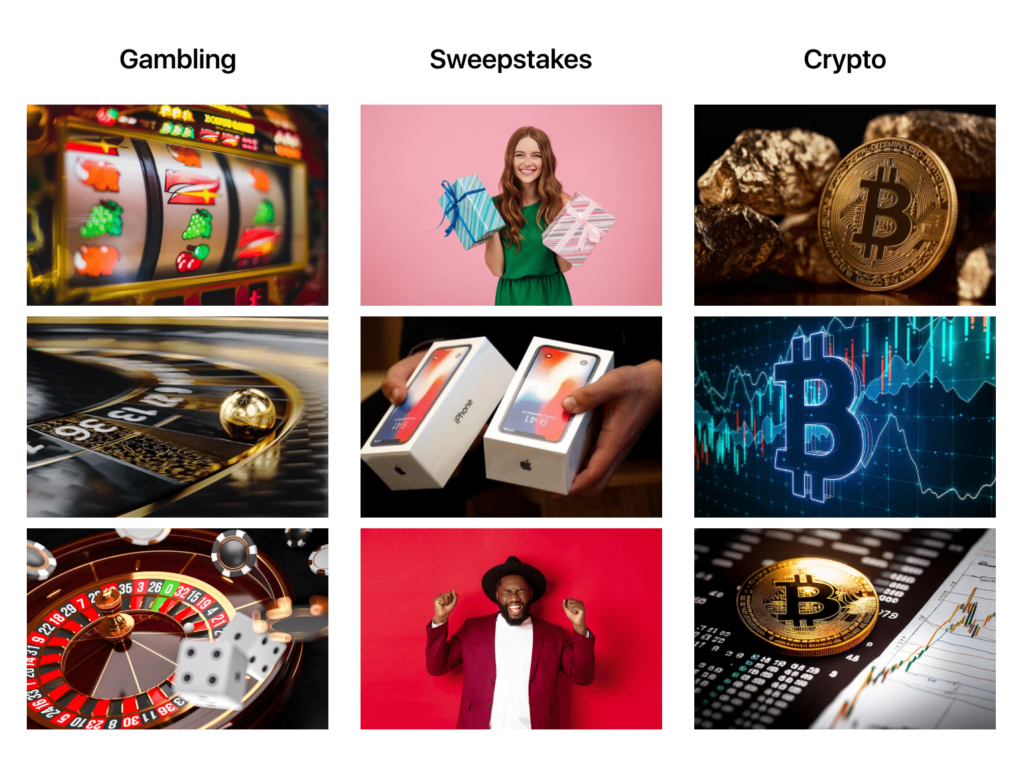
It is preferable to choose a catchy main image that will convey the sense of the offer. The idea of the image must be clear at the first sight. The best practices for image plots are happy people and before-after pictures;
A successful title is short and meaningful at the same time, as well as the description. The format of push notifications is limited to several words, so start with the most important message of your offer.
Use various creatives for your campaigns and change them from time to time. Even the most ordinary creative can come off. Regular updates ensure your ads stay relevant and continuously capture audience attention.
If an ad network divides all available traffic into groups, offering sources of different performance levels, it’s better to seize this opportunity. By choosing premium sources, it is possible to increase CR and reduce CPA when testing only part of traffic. The rule that works here is: “Quantity does not equal quality”. Sources with lower performance and lists of new subscribers can be used for campaign scaling.
Campaigns should be separated for different devices because mobiles and desktops differ only by traffic features. It is definitely worth doing because separation makes optimization easier. To separate campaigns, you need only duplicate the created campaign and replace device settings. The process of creating separate campaigns for devices may be slightly different for diverse ad networks.
Optimization is the power of push format, and it may have an even greater impact on conversion results when its options are would be used to the fullest. For example, you can set up Automated Rules that allow making changes based on the conditions users choose. If you set rules, all low-converting sources can be blacklisted at once. It’s more convenient than excluding each source one by one manually.
Likewise, you can use other optimization features to achieve the best campaign performance. Ways of optimization are numerous, so use any opportunity to improve your campaign and reach the target audience more precisely. Experimenting with different targeting options, ad scheduling, and bid adjustments can further refine your strategy and enhance results.
Push Ads provide advertisers with a non-intrusive and voluntary format. Since traffic comes from visitors who subscribe to notifications independently, advertisers draw a highly-engaged audience and thus reach higher conversion rates than traditional ad formats.
Your campaign performance skyrocket if you are working with such verticals as Gambling, Betting, Dating, Mobile Utility and Finance. Follow our pro tips on choosing the right ad networks, optimization and making attractive creatives to boost up your push notification campaigns.
Nowadays, catching clients’ attention is harder than ever due to digitalization. Push ads solve this task much more effectively in comparison with other ad formats. The secret of push ads’ success is that this ad type is user-friendly and notable. Surely everyone came across push advertising more than once.
Read on to learn more about push notifications: their peculiarities, pros and cons, and how to reach maximum conversion rates through this ad type. Here is a complete push ads review that will be helpful for affiliate marketers, publishers, and anyone who wants to become a push ads guru.
Before diving into the high-level push notification solutions, let’s start with the fundamentals and definitions.
Push notifications are clickable pop-up messages displayed on device screens, chiefly desktops and smartphones. The technology originally served for sending non-advertising notifications. Apple was the first who implemented push technology for its devices in 2009. The company created Apple Push Notification service (APNs) that enabled iOS developers to send notifications to apps installed on Apple devices.
Today push notifications are well-known as advertising technology that is supported by Android, giants Google and Microsoft. Push notification ads also can be viewed almost on most browsers and delivered on any smart devices that are connected to the Internet, for example, tablets and consoles. Despite the fact that push ads appear literally anywhere, they are voluntary. The point is, users should subscribe to notifications before they start receiving push ads.
Push ads are based on the subscription model. Let’s see how it works.
A user visits the website and sees the window with the proposal to subscribe for getting notifications.

Website visitors can click the subscribe button or close the window. Users who choose the first option become push ad recipients soon. They start getting notifications that look something like the following:

Looking at the samples of notifications above, we’ll describe their elements:
See the best push notification examples to create effective marketing push ad campaigns.
All elements are clickable since a push ad contains a URL that allows users to land on the offer page or pre-landing containing a link to the landing page. The pre-landing page serves as part of the sales funnel which is an important stage of the user’s journey and a sort of filter for uninterested ad recipients.

As you’ve seen, the main image is invisible to mobile screens. As a result, ads shown on mobile phones, resemble message notifications that users are accustomed to. Because of this similarity, push advertising is considered to be a type of native format. Unlike other native formats such as SMS and email advertising, push ads can be sent without the user providing contact details. The subscription is totally anonymous for all users.
At present, there are many types of push notifications available for advertising purposes. The most popular formats are the following:
Web push notifications
This technology implies sending out classic push notifications through desktop or mobile browsers. Usually, push ads pop up at the right-hand side or top of the screen, depending on the operating system being used by a subscriber.

In-page push notifications
Unlike classic push notifications, in-page push ads are sort of popunders, stylized as push notifications. Notably, this ad type was invented in order to engage iOS users that hadn’t seen notifications from websites before.

Calendar iOS notifications
These ads are displayed on iOS devices via the сalendar application, imitating a scheduled event. Similar to push ads, users receive calendar notifications right on their devices regardless of whether they are online or not.

It’s worth trying various push formats beyond classic web push notifications, and there is one simple reason for this: whatever the advertising, users get tired of the traditional push ads.
Marketers who decide to try push ads often discover that this format makes more profit than the others. And they have powerful reasons for it.
Benefits of push ads:
Just as every medal has its reverse, push format has its downsides.
Downsides of push ads:
Push advertising is useful as a way to cover a wide variety of verticals. The following verticals tend to have higher click-through and conversion rates than the other ones, which makes them more profitable for marketers.
The list of best verticals for push notifications:
As some verticals, like Adult, Dating (Adult and Mainstream), Gambling, and Sweepstakes are prohibited in social networks, running push ads become almost the only appropriate solution for the promotion of such offers. Note that some restrictions may also be related to the laws of a particular country. For example, Gambling or Betting offers are forbidden for advertising in the United Arab Emirates.
Due to the adaptability of push notifications, it is impossible to say which vertical performs best, but it’s definitely worth focusing on not too-specific offers because of the lack of interest-based targeting.
We’ll explain some technical aspects of push campaigns related to their setup, and then tell you how to get the most out of this knowledge.
The targeting methods for push campaigns and social media campaigns are quite distinct. Social media platforms provide a wider range of targeting options that utilize users’ personal information, such as their age, gender, and interests. Additionally, users actively input this information when creating their accounts.
While social media collect personal data, almost nothing is known about the browser users. Everything you can learn about the target audience comes down to device options, browser parameters and geolocations.
Here are 4 conditional targeting categories in push ad campaigns:
Even though push notifications are voluntary, not all users are equally interested in the notifications they subscribe to. Traffic segmentation helps to discover what audience group is the most effective.
Push traffic can be divided into 2 groups, depending on the following factors:
By targeting premium sources, advertisers can maximize campaign results, while sources with standard or low performance can be used for further scaling.
Most of the used cost models in push advertising are CPC and CPM.
Let’s take a closer look at them:
| CPC | CPM |
|---|---|
| Stands for: Cost Per Click | Stand for: Cost Per Mille (1K impressions) |
| Context: Advertisers pay for only user’s clicks | Context: Advertisers pay for every 1K impressions |
| Best for: Generation of conversion-centered campaigns | Best for: Broad audience marketing, in particular increasing brand awareness |
Read the article to sort out what the model is best for you:
Advertisers often choose the CPC cost model because of knowing how many clicks they can get according to their campaign budget. And on this basis, the CPC model seems to be more simple and less risky, unlike CPM.
To promote their offers, advertisers need publishers who have their own websites. Publishers or site owners, in turn, are interested in collaboration with advertisers because their purpose is to monetize existing traffic. Obviously, publishers can create an opt-in form for collecting subscriptions through a special plugin, but this way takes much time and reach only website visitors.
The most effective way to monetize or buy traffic is cooperation with push ad agencies that meet the needs of both sides:
Push ads networks aggregate many site owners in one place, giving access to a great amount of traffic for advertisers.

Subscribers lists are the largest traffic source in any ad platform. Each list can include several publishers. And accordingly, each publisher can have either one site or multiple ones.

Networks offer full service for creating campaigns, not limited to only the collection of subscriber databases. These are multiple targeting options, subscribers lists prepared for particular verticals, optimization tools and other perks.
Benefits provided by networks:
Often publishers go to networks because they are looking for a more universal solution than just the plugin for collecting subscriptions. As far as marketers, they benefit from a great amount of traffic and multiple tools for optimization in ad networks for publishers.
The diversity of ad networks puzzles many advertisers. This choice is made easier if you know what you need to pay attention to.
The steps we outline below is a basis for any network.
Setting up push campaigns doesn’t imply as many targeting options as social media advertising accounts have. However, push technology provides large volumes of traffic compared to social networks. If a campaign is launched in some ad platform, there are also more opportunities for affiliates to optimize it. Thus, the success of a campaign depends on its proper setup.
Here, we’ll share the secrets of high-performance-based campaigns.
When choosing GEO, advertisers should consider that each country has its level of economic development, needs, culture and laws – all these factors influence on advertiser’s profit.
As GEOs are categorized in a tier system, you can focus on a particular group:
If you choose GEO from the Tier-1 group, you have a chance to get the largest payouts for offers, but the cost of this traffic will be high. Also, you can profit from the high traffic volumes of Tier-3 countries at a low price. The selection of GEO from the Tier-2 group is an alternative to mentioned options.
Choosing GEO impacts the potential amount of traffic that you can get. Affiliates can cover all countries while creating campaigns, provided that they have enough budget and time for testing and this strategy is appropriate.
Users’ attention is one of the most valuable commodities nowadays so push creatives are designed to attract it. Look at a few tips on how to make eye-catching creatives:

Icon should be simple and coupled with the main image. So, complex graphics or over-detailed icon isn’t the best option.

It is preferable to choose a catchy main image that will convey the sense of the offer. The idea of the image must be clear at the first sight. The best practices for image plots are happy people and before-after pictures;
A successful title is short and meaningful at the same time, as well as the description. The format of push notifications is limited to several words, so start with the most important message of your offer.
Use various creatives for your campaigns and change them from time to time. Even the most ordinary creative can come off. Regular updates ensure your ads stay relevant and continuously capture audience attention.
If an ad network divides all available traffic into groups, offering sources of different performance levels, it’s better to seize this opportunity. By choosing premium sources, it is possible to increase CR and reduce CPA when testing only part of traffic. The rule that works here is: “Quantity does not equal quality”. Sources with lower performance and lists of new subscribers can be used for campaign scaling.
Campaigns should be separated for different devices because mobiles and desktops differ only by traffic features. It is definitely worth doing because separation makes optimization easier. To separate campaigns, you need only duplicate the created campaign and replace device settings. The process of creating separate campaigns for devices may be slightly different for diverse ad networks.
Optimization is the power of push format, and it may have an even greater impact on conversion results when its options are would be used to the fullest. For example, you can set up Automated Rules that allow making changes based on the conditions users choose. If you set rules, all low-converting sources can be blacklisted at once. It’s more convenient than excluding each source one by one manually.
Likewise, you can use other optimization features to achieve the best campaign performance. Ways of optimization are numerous, so use any opportunity to improve your campaign and reach the target audience more precisely. Experimenting with different targeting options, ad scheduling, and bid adjustments can further refine your strategy and enhance results.
Push Ads provide advertisers with a non-intrusive and voluntary format. Since traffic comes from visitors who subscribe to notifications independently, advertisers draw a highly-engaged audience and thus reach higher conversion rates than traditional ad formats.
Your campaign performance skyrocket if you are working with such verticals as Gambling, Betting, Dating, Mobile Utility and Finance. Follow our pro tips on choosing the right ad networks, optimization and making attractive creatives to boost up your push notification campaigns.